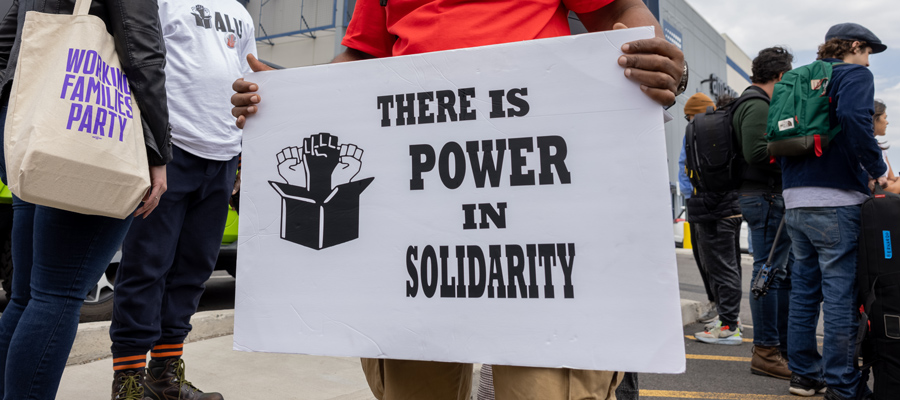Photo: Ben Von Klemperer / Shutterstock
The BC government recently introduced legislation that allows a majority of workers in a workplace to organize a union a little more easily, making it harder for employers to intimidate and interfere in organizing drives. That’s good news both for working people and for the quality of our democracy.
Single-step certification simply means that if a clear majority of workers in a workplace back forming a union—and sign authorization cards declaring this—they are allowed to form one.1 This is actually a return to the traditional framework for union certification in Canada. The single-step process was the norm until the 1980s when governments began rolling it back in many provinces including BC. This rollback was part of a longer trend in cuts to the social safety net and broader anti-labour policies.
Beginning in the 1980s, labour laws were changed in many provinces to make forming a union more difficult, specifically by instituting a two-step process. After a majority of workers had signed union authorization cards, a second step was added requiring a reconfirmation vote to be held. This might sound innocuous (if unnecessary), but the main effect was to give employers a window to run anti-union campaigns and intimidate workers into abandoning organizing drives.
Employer interference campaigns are common and typically include tactics like holding “captive audience meetings” (mandatory anti-union meetings), sending steady streams of text messages and posting anti-union messaging around the workplace, hiring consultants who specialize in union-busting efforts and often simply firing the workers who are most active in the organizing effort.
This rollback was part of a longer trend in cuts to the social safety net and broader anti-labour policies.
Unfortunately, these types of practices are widespread. They have been getting somewhat more media attention recently during an ongoing wave of worker organizing drives at large corporations like Amazon and Starbucks in the United States. But the same tactics are used here in Canada at corporations like Amazon, Starbucks, Tim Hortons and in many lesser-known firms throughout various sectors.
To help reduce these types of practices, BC instituted a set of labour law reforms in 2019, but the province didn’t bring back single-step certification at that time. The 2019 reforms included shortening the gap between the initial application for union certification and the reconfirmation vote, which was aimed at reducing that window of opportunity for employers to interfere.
At that time, the three members of a BC expert panel on labour law agreed that if employer abuses continued after the reforms, the case for returning to single-step certification would be “compelling” (and one member argued that this should have happened immediately in 2019). In announcing the return to single-step certification in April 2022, Minister of Labour Harry Bains cited several recent rulings from the BC Labour Relations Board (LRB) demonstrating ongoing employer interference. For example, in a ruling earlier this year, the LRB found that a waste management company had fired “the union’s chief organizer at the very start of an organizing campaign” and this was “without proper cause and [with] anti-union motivation.”
In a February 2022 ruling, the LRB found that an electrical contractor used tactics such as captive audience meetings to threaten “dire employment consequences” if workers unionized. According to the LRB, “the Employer’s conduct was egregious, and the extent to which it interfered with the fundamental right of employees to decide whether to join a trade union was severe.” In another case in 2020 the LRB found that a food processing firm near Vernon in BC’s interior fired two workers with “the effect of ending the Union’s organizing drive in its tracks,” typical of a “’hit hard, hit early’ strategy of union avoidance.”
While the return to single-step certification won’t mean the end of aggressive anti-union campaigns, it will make them somewhat more difficult to carry out and give workers a fighting chance to form a union. Across jurisdictions, the main effect (and likely aim) of a two-step certification process was always to reduce unionization rates. Research examining BC and other jurisdictions shows this reduction in unionization is exactly what happens.
Single-step certification will give workers a fighting chance to form a union.
Strengthening the right of workers to organize unions has broader implications for tackling extreme inequality and creating more democratic control over our politics. Unions help offset a critical imbalance of power that exists between workers and owners in a capitalist economy. It’s increasingly clear that the rich wield disproportionate influence over politics across the developed world, in some cases blocking progress on many of the most important challenges we face.
For example, last year the BC public overwhelmingly backed instituting a right to 10 paid sick days, a position also strongly supported by health experts and economists. But after intensive lobbying efforts by corporations, the provincial government implemented only five days. Recent policy debates around a wealth tax on the super rich tell a similar story. Despite the support of 89 per cent of Canadians, including large majorities of voters across the political spectrum, a wealth tax is nowhere to be seen.
Stronger unions can help close this alarming gap between the public will and government policy in these types of areas, offsetting and fighting back against the influence of corporate power and the rich. Indeed, a growing body of empirical research suggests that higher unionization rates can help reduce persistent political inequalities wherein the rich exert disproportionate influence.
As my own doctoral research and other analysis has found, working-class people are also severely underrepresented among the holders of legislative office across the developed world, and this lack of direct representation in government is one of the factors contributing to the diminished influence that workers have over public policy. But this too can be changed. The same research finds that where unionization rates are higher, workers are more likely to hold public office.
Despite the support of 89 per cent of Canadians, a wealth tax is nowhere to be seen.
Higher unionization rates are also associated with lower levels of economic inequality, as well as more pay equity between genders driven in part by the pay transparency that collective agreements require. Research has shown that being part of a union and working together in a common struggle with other workers tends to reduce racial prejudice and resentment.
Finally, unions help ensure workers have some element of a democratic voice in capitalist workplaces, which are by their basic structure deeply undemocratic, with owners and managers holding the power in a top-down manner. Unions help workers have a collective voice to partly counterbalance the power of bosses. There’s no reason workers shouldn’t also own and control these companies. Why should democracy stop at the workplace front door? Why shouldn’t workers have more of a direct say in the companies where they generate the profits and spend much of their lives? If that sounds radical, keep in mind that recent proposals along these lines attract high levels of public support across party lines in polling in the US.
Of course, none of this can happen without building working-class power. Corporations and politicians have never handed over rights to workers without a fight. Indeed, big business lobby groups are already mobilizing to try to block the right to single-step certification.
Strengthening the right to unionize is essential not only to workers seeking to raise their wages and improve their working conditions, but also to tackling extreme inequality and deepening democracy. By removing one barrier to forming unions and blunting the effect of corporate anti-union campaigns, the return to single-step union certification is a win for workers in BC.
Notes
1. BC’s proposed new legislation would require 55% of workers in a workplace to sign union authorization cards for the single-step process to be binding. If between 45% and 55% of workers sign, then the current two-step process would still be required.
This article was originally published on CCPA-BC’s Policy Note website.

